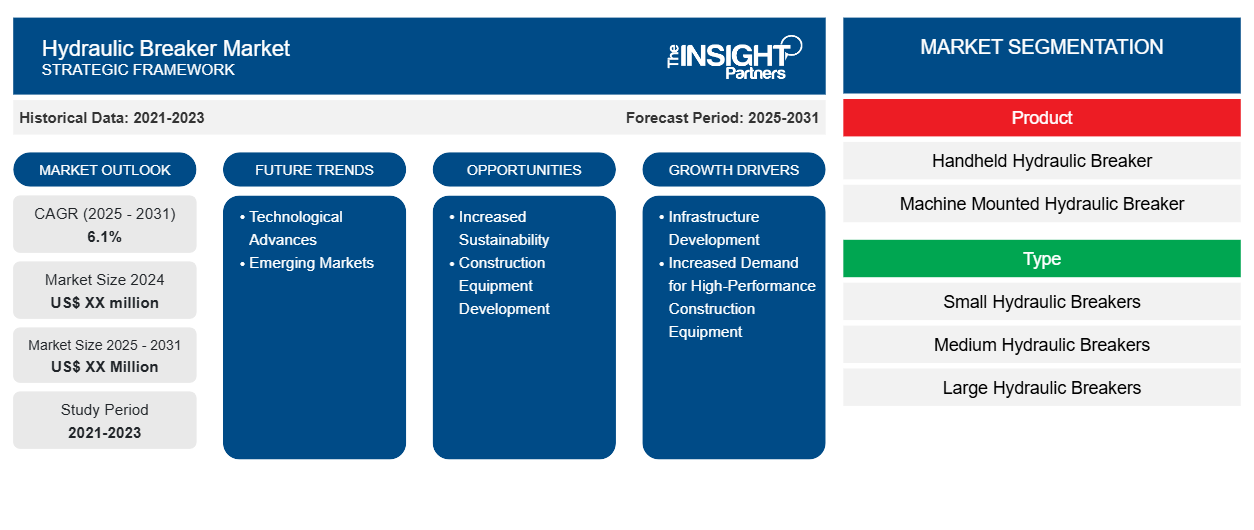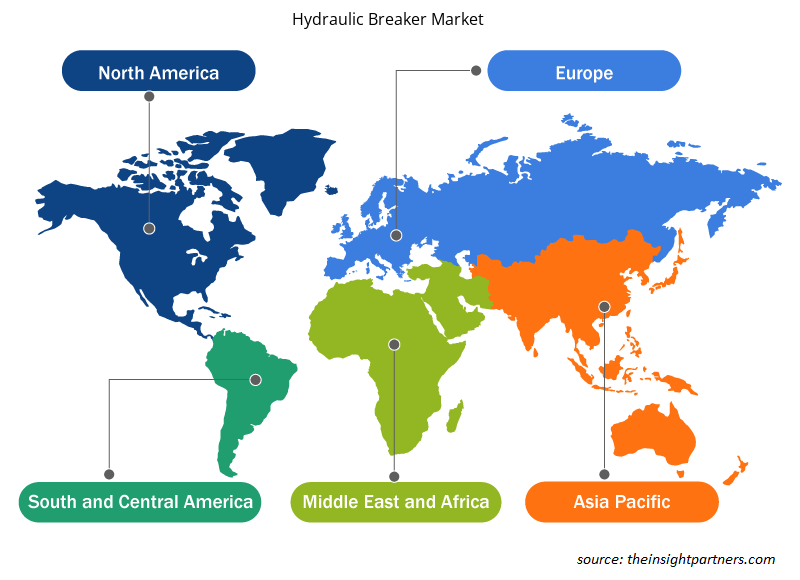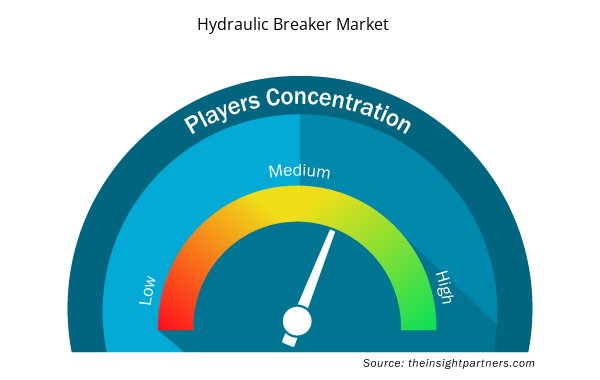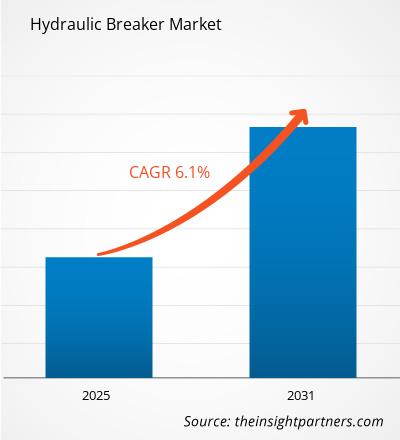Für den Markt für Hydraulikhämmer wird von 2025 bis 2031 eine durchschnittliche jährliche Wachstumsrate (CAGR) von 6,1 % erwartet , wobei die Marktgröße von XX Millionen US-Dollar im Jahr 2024 auf XX Millionen US-Dollar im Jahr 2031 anwachsen wird.
Der Bericht ist nach Produkten segmentiert (Handhydraulikhämmer, maschinenmontierte Hydraulikhämmer). Er enthält außerdem Analysen nach Typ (kleine Hydraulikhämmer, mittlere Hydraulikhämmer, große Hydraulikhämmer). Der Bericht enthält außerdem Analysen nach Endverbrauchern (Bauwesen, Bergbau, Sonstige). Die globale Analyse ist weiter nach Regionen und wichtigen Ländern unterteilt. Der Bericht gibt den Wert in USD für die oben genannten Analysen und Segmente an.
Zweck des Berichts
Der Bericht „Hydraulikhammermarkt“ von The Insight Partners beschreibt die aktuelle Marktsituation und das zukünftige Wachstum sowie die wichtigsten Treiber, Herausforderungen und Chancen. Er liefert Einblicke für verschiedene Geschäftsinteressenten, wie zum Beispiel:
- Technologieanbieter/-hersteller: Um die sich entwickelnde Marktdynamik zu verstehen und die potenziellen Wachstumschancen zu kennen, können sie fundierte strategische Entscheidungen treffen.
- Investoren: Um eine umfassende Trendanalyse hinsichtlich der Marktwachstumsrate, der finanziellen Marktprognosen und der Chancen entlang der Wertschöpfungskette durchzuführen.
- Regulierungsbehörden: Sie regulieren die Richtlinien und polizeilichen Aktivitäten auf dem Markt mit dem Ziel, Missbrauch zu minimieren, das Vertrauen der Anleger zu wahren und die Integrität und Stabilität des Marktes aufrechtzuerhalten.
Marktsegmentierung für Hydraulikhämmer
Produkt
- Handgeführter Hydraulikhammer
- Maschinenmontierter Hydraulikhammer
Typ
- Kleine Hydraulikhämmer
- Mittlere Hydraulikhämmer
- Große Hydraulikhämmer
Endbenutzer
- Konstruktion
- Bergbau
- Sonstiges
Geographie
- Nordamerika
- Europa
- Asien-Pazifik
- Süd- und Mittelamerika
- Naher Osten und Afrika
Passen Sie diesen Bericht Ihren Anforderungen an
Sie erhalten kostenlos Anpassungen an jedem Bericht, einschließlich Teilen dieses Berichts oder einer Analyse auf Länderebene, eines Excel-Datenpakets sowie tolle Angebote und Rabatte für Start-ups und Universitäten
Markt für Hydraulikhämmer: Strategische Einblicke

- Informieren Sie sich über die wichtigsten Markttrends in diesem Bericht.Dieses KOSTENLOSE Beispiel umfasst Datenanalysen, von Markttrends bis hin zu Schätzungen und Prognosen.
Wachstumstreiber des Hydraulikhammermarktes
- Infrastrukturentwicklung: Infrastrukturprojekte wie Straßen, Autobahnen, Brücken und Tunnel treiben den Markt für Hydraulikhämmer rasant an. Urbanisierung und staatliche Investitionen in die Infrastruktur zur Versorgung der Bevölkerung steigern die Nachfrage nach Hydraulikhämmern für Abbruch- und Bauarbeiten.
- Steigende Nachfrage nach leistungsstarken Baumaschinen: Die Nachfrage nach leistungsstarken Baumaschinen, angetrieben durch verbesserte Produktivität und reduzierte Betriebskosten, ist ein wichtiger Treiber. Hydraulikhämmer erfreuen sich großer Nachfrage, da sie Beton und Fels erfolgreich aufbrechen und häufig in Bau- und Abbruchprozessen eingesetzt werden. Dieser Trend hat den Einsatz von Hydraulikhämmern auch in anderen Branchen verstärkt und zu weiterem Marktwachstum beigetragen.
Zukünftige Trends auf dem Markt für Hydraulikhämmer
- Technologischer Fortschritt: Da die Hochleistungs-Hydraulikhammer-Technologien die Energieeffizienz verbessern und den Geräuschpegel senken, sollten die Hersteller nach größeren Gewinnmöglichkeiten suchen. Entwicklungen, die Leistung und Sicherheit verbessern, eröffnen attraktive neue Kunden, während im urbanen Umfeld – dem Ursprung neuer Märkte – der Lärmschutz ein strenger Aspekt ist.
- Schwellenmärkte: In den Schwellenmärkten im asiatisch-pazifischen Raum und Lateinamerika bieten sich hohe Wachstumschancen, da der Infrastrukturausbau an Fahrt gewinnt. Mit den Investitionen in Bau und Urbanisierung steigt auch die Nachfrage nach Hydraulikhämmern. Hersteller erhalten hier die Chance, durch die Gewinnung neuer Kunden weitere Märkte zu erschließen.
Marktchancen für Hydraulikhämmer
- Erhöhte Nachhaltigkeit: Die Baubranche legt zunehmend Wert auf Nachhaltigkeit, und Hydraulikhämmer, die ihre Stärken im Umweltschutz unter Beweis stellen, sind gefragt. Die Unternehmen arbeiten daran, die Auswirkungen auf die Umwelt durch die Herstellung emissionsärmerer und energiesparenderer Produkte zu minimieren. Der verstärkte Fokus auf Nachhaltigkeit ermöglicht dies im Einklang mit globalen Zielen, was die Attraktivität von Hydraulikhämmern auf dem Markt steigert.
- Entwicklung von Baumaschinen: Die Entwicklung von Baumaschinen – ein Trend zu Automatisierung und intelligenten Technologien – beeinflusst auch die Markttrends für Hydraulikhämmer. Zusätzliche IoT- und intelligente Sensoren können an den Hämmern montiert werden, um deren Leistung in Echtzeit zu überwachen und zu optimieren. Dies steigert die Gesamteffizienz und reduziert Zeitverluste durch Ausfälle. Dieser Trend wird die Grundlage für die Entwicklung des Marktes für Hydraulikhämmer bilden, da Unternehmen versuchen, Technologie zur Verbesserung ihrer Betriebsfähigkeiten einzusetzen.
Regionale Einblicke in den Hydraulikhammermarkt
Die Analysten von Insight Partners haben die regionalen Trends und Faktoren, die den Markt für Hydraulikhämmer im Prognosezeitraum beeinflussen, ausführlich erläutert. In diesem Abschnitt werden auch die Marktsegmente und die geografische Lage von Hydraulikhämmern in Nordamerika, Europa, Asien-Pazifik, dem Nahen Osten und Afrika sowie Süd- und Mittelamerika erläutert.

- Erhalten Sie regionale Daten zum Hydraulikhammermarkt
Umfang des Marktberichts für Hydraulikhämmer
| Berichtsattribut | Details |
|---|---|
| Marktgröße im Jahr 2024 | XX Millionen US-Dollar |
| Marktgröße bis 2031 | XX Millionen US-Dollar |
| Globale CAGR (2025 – 2031) | 6,1 % |
| Historische Daten | 2021-2023 |
| Prognosezeitraum | 2025–2031 |
| Abgedeckte Segmente | Nach Produkt
|
| Abgedeckte Regionen und Länder | Nordamerika
|
| Marktführer und wichtige Unternehmensprofile |
|
Marktteilnehmerdichte für Hydraulikhämmer: Auswirkungen auf die Geschäftsdynamik
Der Markt für Hydraulikhämmer wächst rasant. Die steigende Endverbrauchernachfrage ist auf Faktoren wie veränderte Verbraucherpräferenzen, technologische Fortschritte und ein stärkeres Bewusstsein für die Produktvorteile zurückzuführen. Mit der steigenden Nachfrage erweitern Unternehmen ihr Angebot, entwickeln Innovationen, um den Verbraucherbedürfnissen gerecht zu werden, und nutzen neue Trends, was das Marktwachstum weiter ankurbelt.
Die Marktteilnehmerdichte beschreibt die Verteilung der in einem bestimmten Markt oder einer bestimmten Branche tätigen Unternehmen. Sie gibt an, wie viele Wettbewerber (Marktteilnehmer) in einem bestimmten Marktraum im Verhältnis zu dessen Größe oder Gesamtmarktwert präsent sind.
Die wichtigsten Unternehmen auf dem Markt für Hydraulikhämmer sind:
- AB Volvo
- Atlas Copco
- Raupe
- Epiroc
- INDECO NA
Haftungsausschluss : Die oben aufgeführten Unternehmen sind nicht in einer bestimmten Reihenfolge aufgeführt.

- Überblick über die wichtigsten Akteure auf dem Markt für Hydraulikhämmer
Wichtige Verkaufsargumente
- Umfassende Abdeckung: Der Bericht deckt die Analyse von Produkten, Dienstleistungen, Typen und Endbenutzern des Hydraulikhammermarktes umfassend ab und bietet eine ganzheitliche Übersicht.
- Expertenanalyse: Der Bericht basiert auf dem umfassenden Verständnis von Branchenexperten und Analysten.
- Aktuelle Informationen: Der Bericht gewährleistet Geschäftsrelevanz durch die Berichterstattung über aktuelle Informationen und Datentrends.
- Anpassungsoptionen: Dieser Bericht kann angepasst werden, um den spezifischen Kundenanforderungen gerecht zu werden und die Geschäftsstrategien optimal anzupassen.
Der Forschungsbericht zum Markt für Hydraulikhämmer kann daher dazu beitragen, die Branchensituation und die Wachstumsaussichten zu entschlüsseln und zu verstehen. Obwohl es einige berechtigte Bedenken gibt, überwiegen die Vorteile dieses Berichts tendenziell die Nachteile.
- Historische Analyse (2 Jahre), Basisjahr, Prognose (7 Jahre) mit CAGR
- PEST- und SWOT-Analyse
- Marktgröße Wert/Volumen – Global, Regional, Land
- Branche und Wettbewerbsumfeld
- Excel-Datensatz


- Wheat Protein Market
- Legal Case Management Software Market
- Aircraft MRO Market
- Fish Protein Hydrolysate Market
- Biopharmaceutical Contract Manufacturing Market
- Hair Wig Market
- Mobile Phone Insurance Market
- Aesthetic Medical Devices Market
- Redistribution Layer Material Market
- Pressure Vessel Composite Materials Market

Report Coverage
Revenue forecast, Company Analysis, Industry landscape, Growth factors, and Trends

Segment Covered
This text is related
to segments covered.

Regional Scope
North America, Europe, Asia Pacific, Middle East & Africa, South & Central America

Country Scope
This text is related
to country scope.
Häufig gestellte Fragen
Some of the customization options available based on the request are an additional 3-5 company profiles and country-specific analysis of 3-5 countries of your choice. Customizations are to be requested/discussed before making final order confirmation, as our team would review the same and check the feasibility.
The report can be delivered in PDF/PPT format; we can also share excel dataset based on the request.
Increased Sustainability and Construction Equipment Development are the key future trends of the Hydraulic Breaker Market
The leading players operating in the Hydraulic Breaker Market include AB Volvo, Atlas Copco, Caterpillar, Epiroc, INDECO N.A., JCB, Komatsu, NPK Construction Equipment, Inc., Sandvik AB, SOOSAN CORPORATION Co.
The Hydraulic Breaker Market is estimated to witness a CAGR of 6.1% from 2023 to 2031
The major factors driving the Hydraulic Breaker Market are: Infrastructure Development and Increased Demand for High-Performance Construction Equipment
Trends and growth analysis reports related to Manufacturing and Construction : READ MORE..
The List of Companies
1.AB Volvo
2.Atlas Copco
3.Caterpillar
4.Epiroc
5.INDECO N.A.
6.JCB
7.Komatsu
8.NPK Construction Equipment, Inc.
9.Sandvik AB
10.SOOSAN CORPORATION Co.,
The Insight Partners performs research in 4 major stages: Data Collection & Secondary Research, Primary Research, Data Analysis and Data Triangulation & Final Review.
- Data Collection and Secondary Research:
As a market research and consulting firm operating from a decade, we have published and advised several client across the globe. First step for any study will start with an assessment of currently available data and insights from existing reports. Further, historical and current market information is collected from Investor Presentations, Annual Reports, SEC Filings, etc., and other information related to company’s performance and market positioning are gathered from Paid Databases (Factiva, Hoovers, and Reuters) and various other publications available in public domain.
Several associations trade associates, technical forums, institutes, societies and organization are accessed to gain technical as well as market related insights through their publications such as research papers, blogs and press releases related to the studies are referred to get cues about the market. Further, white papers, journals, magazines, and other news articles published in last 3 years are scrutinized and analyzed to understand the current market trends.
- Primary Research:
The primarily interview analysis comprise of data obtained from industry participants interview and answers to survey questions gathered by in-house primary team.
For primary research, interviews are conducted with industry experts/CEOs/Marketing Managers/VPs/Subject Matter Experts from both demand and supply side to get a 360-degree view of the market. The primary team conducts several interviews based on the complexity of the markets to understand the various market trends and dynamics which makes research more credible and precise.
A typical research interview fulfils the following functions:
- Provides first-hand information on the market size, market trends, growth trends, competitive landscape, and outlook
- Validates and strengthens in-house secondary research findings
- Develops the analysis team’s expertise and market understanding
Primary research involves email interactions and telephone interviews for each market, category, segment, and sub-segment across geographies. The participants who typically take part in such a process include, but are not limited to:
- Industry participants: VPs, business development managers, market intelligence managers and national sales managers
- Outside experts: Valuation experts, research analysts and key opinion leaders specializing in the electronics and semiconductor industry.
Below is the breakup of our primary respondents by company, designation, and region:

Once we receive the confirmation from primary research sources or primary respondents, we finalize the base year market estimation and forecast the data as per the macroeconomic and microeconomic factors assessed during data collection.
- Data Analysis:
Once data is validated through both secondary as well as primary respondents, we finalize the market estimations by hypothesis formulation and factor analysis at regional and country level.
- Macro-Economic Factor Analysis:
We analyse macroeconomic indicators such the gross domestic product (GDP), increase in the demand for goods and services across industries, technological advancement, regional economic growth, governmental policies, the influence of COVID-19, PEST analysis, and other aspects. This analysis aids in setting benchmarks for various nations/regions and approximating market splits. Additionally, the general trend of the aforementioned components aid in determining the market's development possibilities.
- Country Level Data:
Various factors that are especially aligned to the country are taken into account to determine the market size for a certain area and country, including the presence of vendors, such as headquarters and offices, the country's GDP, demand patterns, and industry growth. To comprehend the market dynamics for the nation, a number of growth variables, inhibitors, application areas, and current market trends are researched. The aforementioned elements aid in determining the country's overall market's growth potential.
- Company Profile:
The “Table of Contents” is formulated by listing and analyzing more than 25 - 30 companies operating in the market ecosystem across geographies. However, we profile only 10 companies as a standard practice in our syndicate reports. These 10 companies comprise leading, emerging, and regional players. Nonetheless, our analysis is not restricted to the 10 listed companies, we also analyze other companies present in the market to develop a holistic view and understand the prevailing trends. The “Company Profiles” section in the report covers key facts, business description, products & services, financial information, SWOT analysis, and key developments. The financial information presented is extracted from the annual reports and official documents of the publicly listed companies. Upon collecting the information for the sections of respective companies, we verify them via various primary sources and then compile the data in respective company profiles. The company level information helps us in deriving the base number as well as in forecasting the market size.
- Developing Base Number:
Aggregation of sales statistics (2020-2022) and macro-economic factor, and other secondary and primary research insights are utilized to arrive at base number and related market shares for 2022. The data gaps are identified in this step and relevant market data is analyzed, collected from paid primary interviews or databases. On finalizing the base year market size, forecasts are developed on the basis of macro-economic, industry and market growth factors and company level analysis.
- Data Triangulation and Final Review:
The market findings and base year market size calculations are validated from supply as well as demand side. Demand side validations are based on macro-economic factor analysis and benchmarks for respective regions and countries. In case of supply side validations, revenues of major companies are estimated (in case not available) based on industry benchmark, approximate number of employees, product portfolio, and primary interviews revenues are gathered. Further revenue from target product/service segment is assessed to avoid overshooting of market statistics. In case of heavy deviations between supply and demand side values, all thes steps are repeated to achieve synchronization.
We follow an iterative model, wherein we share our research findings with Subject Matter Experts (SME’s) and Key Opinion Leaders (KOLs) until consensus view of the market is not formulated – this model negates any drastic deviation in the opinions of experts. Only validated and universally acceptable research findings are quoted in our reports.
We have important check points that we use to validate our research findings – which we call – data triangulation, where we validate the information, we generate from secondary sources with primary interviews and then we re-validate with our internal data bases and Subject matter experts. This comprehensive model enables us to deliver high quality, reliable data in shortest possible time.

 Holen Sie sich ein kostenloses Muster für diesen Bericht
Holen Sie sich ein kostenloses Muster für diesen Bericht